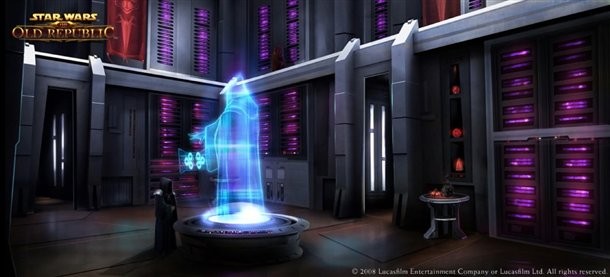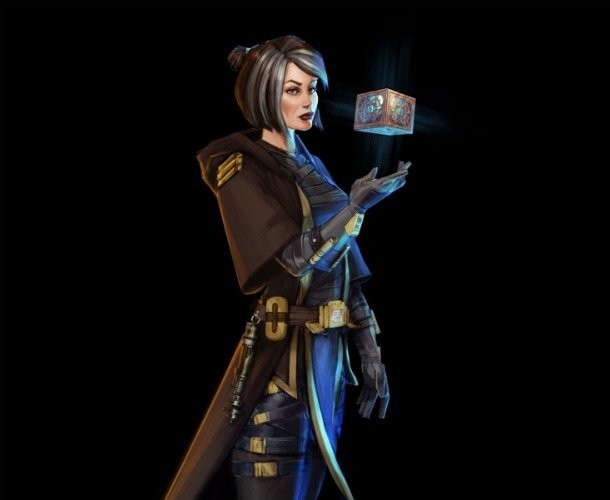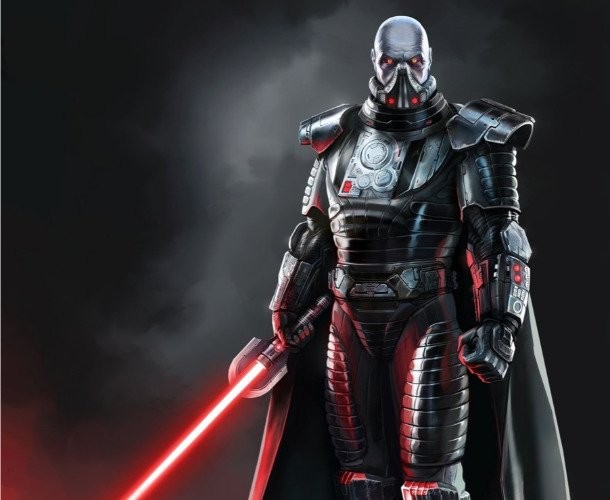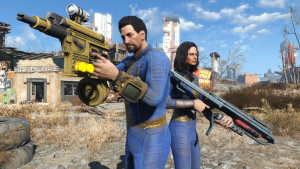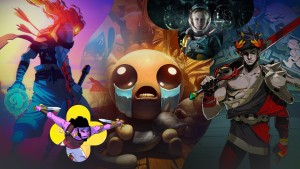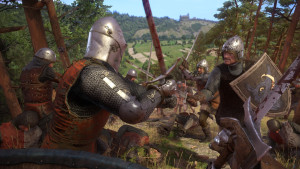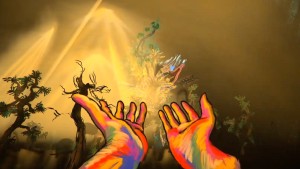Please support Game Informer. Print magazine subscriptions are less than $2 per issue
Storytelling In Star Wars: The Old Republic
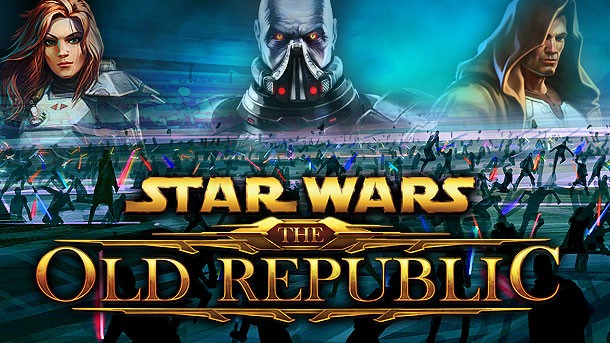
Perhaps you’re like us. You know The Old Republic is coming, and it sounds like it could be pretty exciting. The massively multiplayer mindset behind World of Warcraft wedded to the choices and story components of a BioWare RPG – not a bad mix. But how will the company that brought us Mass Effect and Dragon Age accomplish such a task? We wondered the same thing, so we tracked down Daniel Erickson, lead principal writer on The Old Republic, and quizzed him on the game’s approach to storytelling, characters, and plot. We came out of the conversation with a deeper understanding of all things story in the Old Republic. Read ahead to learn new details on the complex morality system and multiplayer role-playing conversations of the game. Then dive into the game's comprehensive backstory to learn the intricacies of the its fiction. And, finally, meet the central characters of The Old Republic months before you’ll see them in the game.
First up: Writing one of the biggest games ever
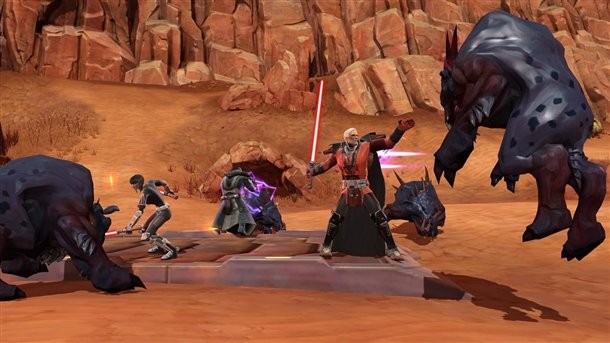
Different Perspectives
The writing team working on The Old Republic has a big challenge in front of them: Create a story that can speak to hardcore Star Wars movie fans, role-playing gamers who loved the Knights of the Old Republic games, as well as MMO players who may not have a deep knowledge of Star Wars at all.
The solution to the dilemma lies in finding ways to speak to each unique audience, while respecting that any one user is coming at the game from their own unique understanding of the Star Wars fiction. “One of the great things about Star Wars as a medium for telling stories, whether it be comics, books, or games, is that it’s more about character types and larger themes and ideas than it is about specifically Han, Luke, and Leia,” explains Erickson. “We’ve extracted all the archetypes from the movies and put them in a different time period. So although the specific characters are different, and the stories that are being developed are new, the world is very familiar. People who have only seen the movies, or even that whole new generation that really is connected to Clone Wars more than anything else, these people are going to come in and see a very recognizable setting. That said, once people get into it, it’s a massively different conflict. What you have in the movies is an insurrection. You’ve got a rebellion that is running and hiding, trying to fight back against a much more powerful force. What you have in the Old Republic is an invasion that is much closer to a European World War I or II scenario than it is to an armed rebellion.” Console RPG players will have the chance to re-embrace the storylines began in KoTOR, learning more about the tale of Revan and Darth Malak, and the aftermath of their grand conflict. Gamers looking for something new after years in another MMO can find familiar faction-based gameplay, classes, and other common MMO tropes.
This first cinematic trailer was one of the first glimpses many people had of the new Star Wars game
The demands of a fiction that can appeal to all those different types of players are significant. To do so, it’s necessary to offer lots of genuine choices to players right from the beginning, letting them live out their Star Wars fantasies as a lightsaber-wielding Jedi or a dangerous bounty hunter. Needless to say, the logistics of presenting such a massive plot is a major undertaking, and one that is only complicated by the presence of lots of existing fiction. Old Republic comic books and novels already exist, not to mention the vast body of information about the wider Star Wars mythology.
“We’ve recently brought in another writer. And it’s always interesting, because the first few weeks are just reading documentation,” Erickson tells us. “Just the fiction bible is well over 1000 pages now. And that’s just our time period. Forget KoTOR or the rest of the enormous Star Wars canon, or the Holocron, which is the enormity of Lucas’ bible for all things Star Wars.” The Old Republic story bible details the events that led up to the game, the characters that populate the galaxy and their full history, and even cultural ideas that prevail in different factions and races. To keep things consistent, one of Erickson’s big jobs on the project is keeping track of it all. Every comic book, novel, or other concept even tangentially connected to The Old Republic comes across his desk. It also goes through Lucas Licensing for a further check against existing fiction. Not only does this process help to assure some preservation of a solid canon, it also lets Erickson cherry pick elements to implement into the game: “The other thing it gives us – there were some very interesting characters that were coming out of the novels. And I will grab them. I will say: ‘I want that girl, and I want that smuggler guy, and boom! They’re going in the game.’ So it becomes a big cycle.”
Next up: Multiplayer role-Playing, choice, and morality in The Old Republic
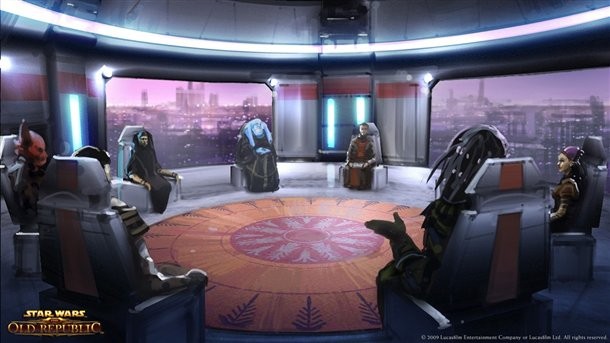
Story In Gameplay
Erickson had lots to say about the complex backstory and characters of The Old Republic. But even for players uninterested in the complex interplay of fictions and characters that lead up to the game, there are a number of features within the gameplay itself that should catch your attention. While The Old Republic shares many baseline features in common with traditional MMOs, its questing and role-playing mechanics share more in common with single-player RPGs, or even tabletop role-playing.
Every character class in The Old Republic has its own complete story. “Each one of these, from a quest perspective, is larger than the original Knights of the Old Republic,” Erickson says. “By far, as an MMO, our game needs to be massively larger. Each of the eight classes has a plot that takes them all the way from the beginning of the game to the end, and has as many choices and ins and outs. So if you’re one of those players who wanted to play Knights of the Old Republic twice to see all the content, well, guess what? Now you’ve got to play 16 times. Because each class has that much variation in it, and all the light side/dark side decisions.” Play a Jedi Knight, and you’ll experience a fundamentally different game than someone else playing a smuggler. If the potential for replay sounds pretty vast, then you’re beginning to catch on about what makes The Old Republic so ambitious.
“But, that’s not all the content that you’re doing,” Erickson assures us. “Interspersed in there is what we call the world content. While the class content tends to be about very specific things. In the movies, Han’s story is about the Hutts, his morality, and learning to be a good guy. In the midst of that, he’s in this grand story about the Rebellion.” Neither group are “side missions”; both are central experiences that forward the storyline. “As you go on in time, the percentage of class content goes down, and the percentage of world content goes up. Not because you have less class content numerically, but because you have far more world quests. The world gets bigger and bigger,” Erickson says. The class stories and world content dovetail. Often, the events you learn about in a class storyline help to inform a deeper understanding of what’s going on in the larger world conflict.
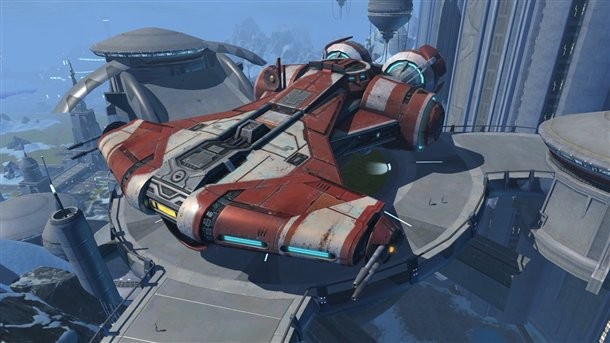
Players will have their own ships in the game, which they can use to reach story missions across the galaxy
All of these missions, whether focused on your class or dealing with grander schemes, can be tackled with a group. “We looked at the way people play MMOs. What we saw was that a large number of players play their MMOs virtually solo,” Erickson describes. “They group up when they need to do stuff; they group up for big things. But a lot of times, they play more by themselves. And the amount that they play multiplayer goes up with time.” To meet this curve, BioWare has built the game to follow that playstyle. “Our biggest challenge was the multiplayer storytelling system,” Erickson continues. “We were doing experiments on this way back on Dragon Age, before we came down here. How do you put multiple people in one conversation with an NPC? We were trying to recreate the old pen and paper feel of having a bunch of people around a table arguing."
On top of your various story missions, you’ll also have companions that join you along the way. “Each of the classes has their own suite of companion characters. So all of your companion characters are your own, with all of their stories, and your interaction with them.” Erickson tells us. “If you’re used to a traditional BioWare games, it is handled like that, but with even more content. They all have their own stories, their own motivations. They all have different reactions to what you do. From a combat perspective, we had an interesting challenge because you can’t hit space bar and pause the server. But we wanted to make them very robust. You already have our advanced class system, which effectively turns the eight classes into 16. But then the companions are effectively another multiplayer option. Story gamers are going to take out their companion that they love. They’re going to take out the companion that they’ve building up affection with, unlocking new content, maybe they’re in a romance. Power gamers are going to look and say, ‘Which of my tool box do I want today?’”
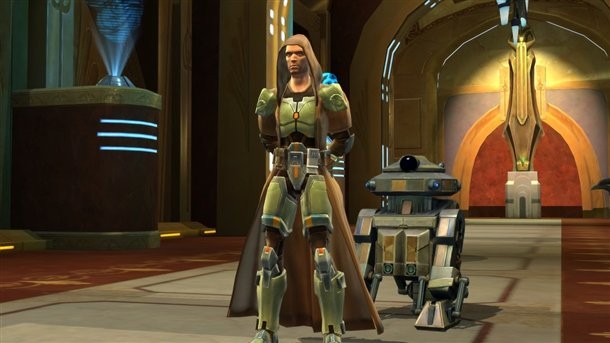
Companion characters can be droids, combat allies, or even romantic partners
What makes this equation more compelling is the addition of a morality system – a touchstone aspect of the Knights of the Old Republic game franchise that is transferring to the new MMO. “There is a completely different concept between faction and morality,” Erickson explains. “You can be a Sith that ends up being entirely light side. There is as much flexibility to every class story as what you’d see in any of our full products.” That means you can play as a member of the Sith Empire or the Republic, and pursue a light side or dark side character for either side. “It’s much harder to be a light-side Sith,” Erickson cautions. “You have to work for it.” This approach dramatically expands the potential outcomes of every storyline into branching paths of good and evil.
To communicate this complex morality tale, BioWare has altered its approach to conversation and mission completion. Actions now speak louder than words, and players won’t be punished for choosing conversation options that don’t match with their morality scale. “It doesn’t matter what you say in TOR. It matters what you do. It doesn’t make a lot of sense for a Sith Warrior to go up to his master and say ‘I believe in kindness and freedom and kittens.’ That guy is dead before he hits the hallway. So, instead, you can go to your master and say, ‘yes, go kill some younglings, I am so down with that’, but it’s when you get there that you have to decide if you’re actually going to kill the younglings, or shuffle them out the side door and tell your master you killed them, that’s when you get your light side/dark side points.” So, no matter what you say to a quest giver or other NPC, it is your actions on the missions that will determine the effect on your light side vs. dark side spectrum.
This approach to conversation will hopefully make for much more lively and amusing conversation options, particularly when playing in a group. The Old Republic implements a multiplayer conversation system, allowing all the participating characters to chime in when conversing with an NPC. By freeing players to choose the dialogue options they like the most, Erickson hopes to evoke the banter and laughter that comes out in a true tabletop RPG setting.
Next up: The backstory that informs The Old Republic
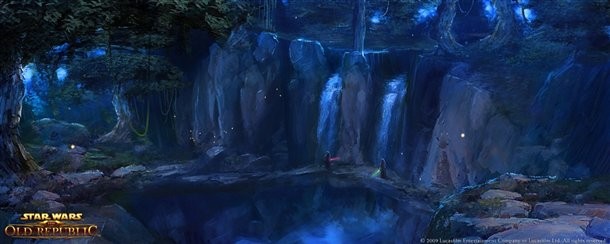
A Long Time Ago...
Brace yourself. This is about to get serious. Here is where you can look to find the history of events and characters that precedes The Old Republic.
The lore behind Star Wars traces back tens of thousands of years, to the very founding of the Jedi Order and the Republic. However, the real meat of the story, as it relates to the new BioWare game, begins with the Great Hyperspace War. It was during this time, (over 1,000 years before the beginning of the new game) that the Sith were expelled from known space and they began their long exile. The Republic continued on, and assumed the Sith had been wiped out.
Players of Knights of the Old Republic will remember the series of events that occurred several hundred years later, surrounding two Jedi known as Revan and Malak. “There are a lot of unanswered questions that fans had there,” Erickson says. “One of the big ones is, after Knights II, it’s made clear that Revan went back into deep space to address the issues of whatever had turned him and made things go bad in the first place. But they’re kind of vague about it. So we picked that up, and took it, and said that we’re going to answer that question.” In the first KoTOR Revan and Malak defied the orders of the Jedi Council, and entered into war against the Mandalorians. This triggered a series of events that would send Revan and Malak off into deep space. What players of those first games don’t know is what happened while they were away.
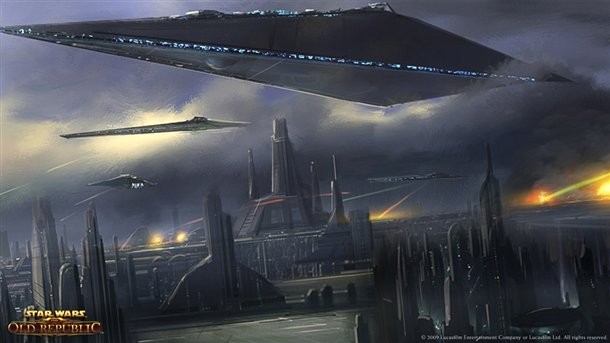
During their exile, they met the Sith and their dangerous emperor, who turned them to the dark side. The two former Jedi were sent back to the Republic to rediscover the ancient Star Forge, a powerful weapon created by the lost civilization of the Rakata. With the powerful weapon, the Sith emperor would be able to accelerate his plans to return and strike down the Republic. “They were supposed to be the forward scouts that set everything up for the emperor,” Erickson explains. “But, being Sith, they did what they normally do, and warred with each other. Messed everything up.” Malak betrayed and murdered Revan. Or so he thought. Revan was wounded, but not killed. In a controversial move, the Jedi council erased Revan’s memory, retrained him, and sent him out to defeat Malak. Malak was defeated, the Star Forge destroyed, and Revan proclaimed a hero. However, Revan had dark memories of the true evil facing the Republic, and he departed once again into deep space, seeking the Sith Emperor, and was never heard from again. So, will we find out Revan’s fate, along with the fate of the Exile from KoTOR II that followed him? “All of your KoTOR 1 and 2 questions will be answered,” Erickson promises.
Almost 300 years later, and about 50 years before the beginning of the new game, the Sith returned. “When they appear back in Republic space, it is with complete surprise, and at full force,” Erickson tells us. “We get less of a war at the beginning than just a full scale slaughter. Planets fall by the dozens.” The Republic Senate rapidly began to splinter over how to respond to the aggression, Only the quick thinking and decisive action of the Jedi slowed the assault, as they acted as one to stem the tide of the oncoming horde of attackers.
The assault on Alderaan was a major turning point in the war, as depicted in this recently released cinematic
As the Sith Empire continued its assault, the full breadth of their machinations was revealed, most significantly through their manipulations of the Mandalorians. By backing a powerful new warrior’s rise to power, the empire gained a strong ally in their quest for galactic supremacy.
After countless battles and victories on both sides, the decisive strike came under the guise of a call for peace. The Sith were clearly winning the war, but they reached out seeking a treaty conference on Alderaan. “The Jedi have this odd concept that since we’ve fought this same war against the same people every 500 or 1000 years for eternity, maybe they can’t be trusted. But the Republic goes anyway. Politics got in the way,” Erickson explains. Huge numbers of Senate diplomats left Coruscant for the summit, necessitating an equally daunting number of Jedi protectors. The Republic capital of Coruscant was left with a skeleton defense.
As the Jedi had feared, Coruscant was struck by the full power of the Sith Empire. The Jedi Temple was devastated, and the planet was held captive. “Back on Alderaan, as they think they’ve been duped, we’re back at war, the Sith explain that they still want to sign the peace treaty, but you’re going to sign it exactly the way we want it, or there is going to be no peace, and no Coruscant,” Erickson details. “One of the enduring mysteries is what they wanted. They wanted the territories they had already taken, but they also wanted about half-a-dozen worlds that weren’t looked at as any particular use for anyone. So there was this major move, but then the treaty that the Republic is forced to sign is not terribly onerous and it included these strange things that has had the Republic paranoid for a decade.” The Republic and their Jedi forces withdraw from contested planets across the galaxy, and a tense peace settles after decades of conflict.
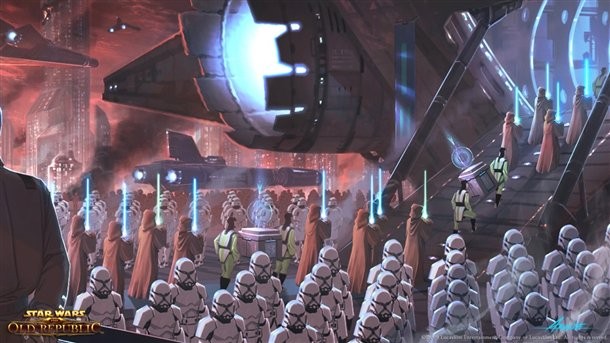
In the aftermath, the Jedi were blamed for the sundering of the Republic. The order chose to leave Coruscant, and withdrew to their origin world of Tython to meditate and plan their next steps. “The politicians like to use the Jedi as scapegoats. And that’s the reason that the Jedi have retreated a little bit back to their home planet,” Erickson says. “And they’re trying to keep themselves clean of the politics while still defending the Republic.”
As Star Wars: The Old Republic begins, the galaxy sits in a state of proxy war. The Republic and the Empire are ostensibly at peace, but hundreds of conflicts play out across the galaxy as each side’s forces continue the fight through espionage, diplomacy, and open skirmishes.
Next up: The major players in the sweeping conflict of The Old Republic
At the heart of Star Wars: The Old Republic lie several characters who are shaping the galaxy’s future, and any player of the game is likely to hear about and encounter some of these personages.
“Satele Shan is the head of the Jedi order in our time period,” Erickson says. Ensconced on Tython, she acts as a calming influence in galactic politics. Devoted players may recognize the name – Satele Shan is the descendant of Bastila Shan, the intrepid Jedi who fought at the side of the Revan during the events of the first Knights of the Old Republic. There are even some who believe Satele is part of a line that began with the child of Revan and Bastila.
Equally important to the Republic are its military leaders, including an entrenched veteran of the war with questionable ethics. “General Garza is one of our very prominent figures,” Erickson says. “She is actually head of all special forces operations in the Republic. She is an older woman – hard as nails, definitely the ends justify the means kind of person, which puts you an interesting position if you’re playing as a trooper. She has very little patience for any of the politics.” As the game begins, she’s become an insistent proponent for the advancement of Republic interests at any cost.
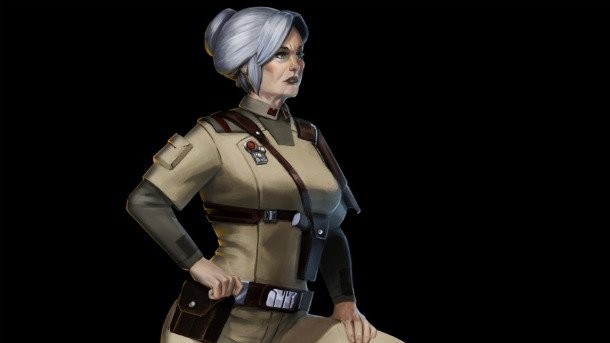
On the other side of the conflict stands the Sith Dark Council. These 12 Sith masters are in charge of the day to day operations of the Empire. “Each member of the Council controls a very specific part of the Empire – not spatially, but thematically. Like one guy is in charge of Sith history and relics. One person is more in charge of intelligence. There’s also a mystery going on,” Erickson continues. “According to what everyone is taught, the Emperor is almighty and all-knowing, and he has been around for a thousand years. He saves the Sith from the Jedi when the Jedi tried to exterminate them a thousand years ago. And led them out into deep space, where they lost the Jedi, and managed to find their original home planets. The interesting thing is that no one who is alive, outside of the Dark Council, has ever seen the Emperor. There are rumors and conspiracies that abound as to whether he is real, whether he is one of the Dark Council, whether he is dead. It makes for all sorts of intriguing power games.” Only the Council ever sees him. Some believe the Emperor doesn’t even exist, and is another lie propagated by the deceitful Sith. The truth will be revealed to players of the game.
Standing in the shadows around the Dark Council is Darth Malgus. As the Sith Lord who was at the forefront of the assault on Coruscant and the destruction of the Jedi Temple, he has the grudging respect of the other Sith. Yet, for some reason he abstains from the political plays and power bases that are central to the Sith hierarchy. “Malgus is a figure who was instrumental in the war, but never made a run for the Dark Council. He instead walked away after the treaty was signed as a vocal critic of it. He’s openly critical of the Dark Council, but at the same time, he has no visible power base, so he’s no clear threat.” Ultimately, his motives remain uncertain.
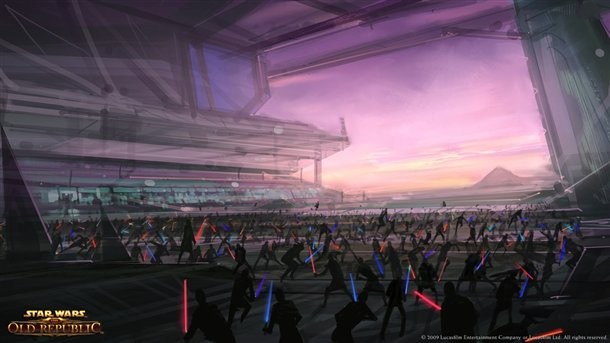
The State of the Galaxy
“As the game begins, you’ve got a lot of tension in the air,” Erickson concludes. “Nobody on either side, except the most optimistic people, believe the peace can hold. Neither side wants to be seen as the side that broke the peace. So there are a lot of attempts to antagonize and make the other side look bad, and thus sway galactic opinion.” Like the Galactic Civil War that will follow 3000 years later, the setting for the Old Republic represents one of the most dramatic moments in the history of the Star Wars galaxy. The stage is set for one of the most ambitious storytelling ventures in video gaming history. It remains to be seen whether the complex of interplay of multiplayer, plotting, and characters can come together. But if there’s anyone we’d like to see make the attempt, it’s most certainly BioWare. And there are few properties more exciting in which to see the attempt made than the sprawling galaxy of Star Wars.
For more on Star Wars: The Old Republic, don’t miss out on all the great content that is already available at the game’s official website.
